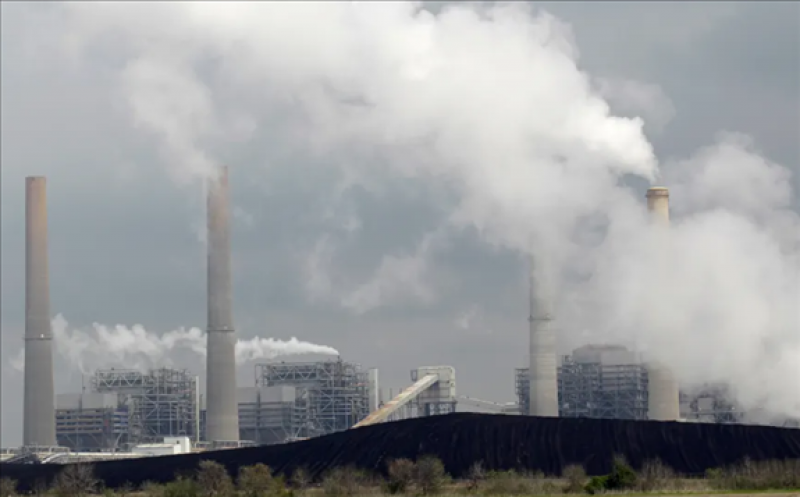Early last year, the Trump administration’s Department of Energy celebrated a special birthday. “Happy Third Operating Anniversary, Petra Nova!” the agency trumpeted in a press release. The release boasted of a coal-fired power plant in Texas that seemed to have done the impossible: It successfully removed carbon dioxide from the plant’s emissions for three years, safely storing them.

The celebration was early—Petra Nova barely made it to its fourth birthday before being shuttered. Last week, NRG Energy, which owns the project, announced that it would be shut down indefinitely, in what may be one of the last gasps for carbon capture and storage technology in the U.S.
On paper, carbon capture and storage, or CCS, sounds like the solution to all our problems. If we could just suck the carbon dioxide emitted by burning fossil fuels and put it somewhere else, we could cut warming without shifting away from old methods of generating energy. In practice, though, the results have been less than promising and failed to scale at anywhere near the levels needed to avert catastrophic climate change.
Decades of research has made CCS technically feasible, but it’s both incredibly complex and wildly expensive. Petra Nova was the only operational CCS project in the U.S., and the largest one in the world using its specific technology. While other projects have attempted to get off the ground in the U.S., there have been some painfully high-profile failures, including one plant in Mississippi where costs ballooned more than 200 percent to $7.5 billion without ever actually coming online. Nevertheless, the fossil fuel industry continues to chase after carbon capture. Just this week, ExxonMobil said that it was investing $3 billion over the next 5 years on projects to lower emissions, including 20 carbon capture projects around the world.
Petra Nova looked at first to be a bright point for CCS before flaming out last week.
“What NRG always touted was that they were on time and on budget,” Daniel Cohan, a professor of environmental engineering at Rice University, said. “The Trump administration flew in journalists from across Europe to show Petra Nova as an example of clean coal technology...It became the poster child of what carbon capture could do.”
But creating technology to remove emissions from burning coal didn’t come without a cost: In purporting to solve some fossil fuel problems, the project actually made some new ones. The CCS technology at Petra Nova required so much energy that NRG made an entirely separate natural gas power plant—the emissions of which were not offset by the Petra Nova technology—just to power the scrubber.
The presence of CCS technology, Cohan noted, also didn’t mean that the rest of the plant was totally clean. While CCS technology can help cut down on other pollutants like sulfur and nitrogen, the Petra Nova technology only affected one of four coal units at NRG’s power plant. Those units were built in the 1980s and have minimal pollution controls, Cohan said, making the power plant “one of the deadliest plants in Texas” in terms of asthma impacts on surrounding communities.
And ironically, the carbon dioxide pulled from the plant’s emissions was actually used to make more fossil fuels. Part of NRG’s deal with the federal government for running Petra Nova was gaining permission to transport the carbon dioxide scrubbed from burning coal to a separate oil field, where it was injected underground to help release more oil.
In a twist of fate, this oil was what ultimately killed Petra Nova. After the crash in oil prices at the start of the pandemic last spring, NRG took the CCS project offline, stating that the price of the oil it could get with the extracted carbon dioxide wasn’t worth the cost of actually doing the extracting. Prices have stayed low even as the economy recovered somewhat. Oil companies large and small have struggled to deal with the fallout from the pandemic, and the writing seemed to be on the wall before NRG’s official announcement last week: It was simply too expensive to keep Petra Nova running.
Despite repeated technical problems and suspicions that NRG overestimated the amount of carbon dioxide the project actually pulled from burning coal, Petra Nova ultimately proved that you could get a CCS project of that size up and running. Cohan said Petra Nova’s legacy could be important for certain industries where use of fossil fuels is unavoidable, or give some hope for big new coal plants with long lifespans being built overseas while also helping to mitigate the health impacts of those plants.
But just because something can be done doesn’t mean it should be done. Petra Nova was designed in 2014, when renewable energy cost a lot more in the U.S. than it does now. The plunging price of renewables over the past few years, Cohan said, means that using fossil fuels to power the grid makes increasingly less sense economically.
“Right now, the cheapest way to make electricity is solar and wind,” Cohan says. “It no longer makes sense to keep an old coal plant around to capture its carbon when you could far more affordably replace it with cleaner sources.”
This article is reproduced at earther.gizmodo.com